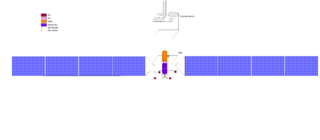
SBS 4 was a geostationary communications satellite designed and manufactured by Hughes on the HS-376 platform. It was ordered by Satellite Business Systems, which later sold it to Hughes Communications. It had a Ku band payload and operated at 94°W longitude.

MEASAT Satellite Systems Sdn. Bhd, formerly Binariang Satellite Systems Sdn. Bhd is a Malaysian communications satellite operator, which owns and operates the MEASAT and AFRICASAT spacecraft. The company provides satellite services to leading international broadcasters, Direct-To-Home (DTH) platforms and telecom operators. With capacity across six communication satellites, the company provides satellite services to over 150 countries representing 80% of the world's population across Asia, Middle East, Africa, Europe and Australia.
The Morelos satellites are a series of Mexican communications satellites. The first two operated between 1985 and 1998 and provided telephony, data, and television services over the territory of the Mexican Republic and adjacent areas. The third is now part of the MEXSAT constellation but carries the Morelos name.
BSAT-2a, was a geostationary communications satellite operated by B-SAT which was designed and manufactured by Orbital Sciences Corporation on the STAR-1 platform. It was stationed on the 110° East orbital slot along its companion BSAT-2c from where they provided redundant high definition direct television broadcasting across Japan.
BSAT-2b, was a geostationary communications satellite ordered by B-SAT which was designed and manufactured by Orbital Sciences Corporation on the STAR-1 platform. It was designed to be stationed on the 110° East orbital slot along its companion BSAT-2a where it would provide redundant high definition direct television broadcasting across Japan.
BSAT-2c, was a geostationary communications satellite operated by B-SAT and was designed and manufactured by Orbital Sciences Corporation on the STAR-1 platform. It was stationed on the 110° East orbital slot along its companion BSAT-2a from where they provided redundant high definition direct television broadcasting across Japan.
BSAT-3a, is a geostationary communications satellite operated by B-SAT which was designed and manufactured by Lockheed Martin on the A2100 platform. It is stationed on the 110° East orbital slot along its companion BSAT-3b and BSAT-3c from where they provide redundant high definition direct television broadcasting across Japan.
BSAT-3b, is a geostationary communications satellite operated by B-SAT which was designed and manufactured by Lockheed Martin on the A2100 platform. It is stationed on the 110° East orbital slot along its companion BSAT-3a and BSAT-3c from where they provide redundant high definition direct television broadcasting across Japan.
BSAT-3c, also known as JCSAT-110R, is a geostationary communications satellite operated by SKY Perfect JSAT Group (JSAT) which was designed and manufactured by Lockheed Martin on the A2100 platform.
BSAT-4a, is a geostationary communications satellite ordered by B-SAT and designed and manufactured by SSL on the SSL 1300 platform. It is expected to be stationed on the 110° East orbital slot for direct television broadcasting of 4K and 8K Ultra HD resolutions.
The JSAT constellation is a communication and broadcasting satellite constellation formerly operated by JSAT Corporation and currently by SKY Perfect JSAT Group. It has become the most important commercial constellation in Japan, and fifth in the world. It has practically amalgamated all private satellite operators in Japan, with only B-SAT left as a local competitor.
JCSAT-1 was a geostationary communications satellite designed and manufactured by Hughes on the HS-393 platform. It was originally ordered by Japan Communications Satellite Company (JCSAT), which later merged into the JSAT Corporation. It had a Ku band payload and operated on the 150°E longitude until it was replaced by JCSAT-1B.
JCSAT-2 was a geostationary communications satellite designed and manufactured by Hughes on the HS-393 platform. It was originally ordered by Japan Communications Satellite Company (JCSAT), which later merged into the JSAT Corporation. It had a Ku band payload and operated on the 154°E longitude until it was replaced by JCSAT-2A.
SBS 2 was a geostationary communications satellite designed and manufactured by Hughes on the HS-376 platform. It was ordered by Satellite Business Systems, which later sold it to Hughes Communications. It had a Ku band payload and operated on the 117°W longitude.
SBS 6 was a geostationary communications satellite designed and manufactured by Hughes on the HS-393 platform. It was originally ordered by Satellite Business Systems, which later sold it to Hughes Communications and was last used by Intelsat. It had a Ku band payload and operated on the 95°W longitude.
The Hughes 393 (sometimes referred to as the HS-393 is a communications satellite bus introduced in 1985 by Hughes Space and Communications Company. It was a spin-stabilized bus that had twice as much power as the HS-376 platform.
The GEOStar is a family of satellite buses designed and manufactured by Orbital ATK. The family started focused on small geostationary communications satellites. The first iterations focused on the sub-5 kW commercial segment that was left vacated after the retirement of the HS-376 satellite bus. It started with the STARBus on CTA Space Systems, which was later bought by Orbital Sciences.








